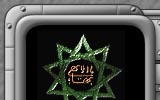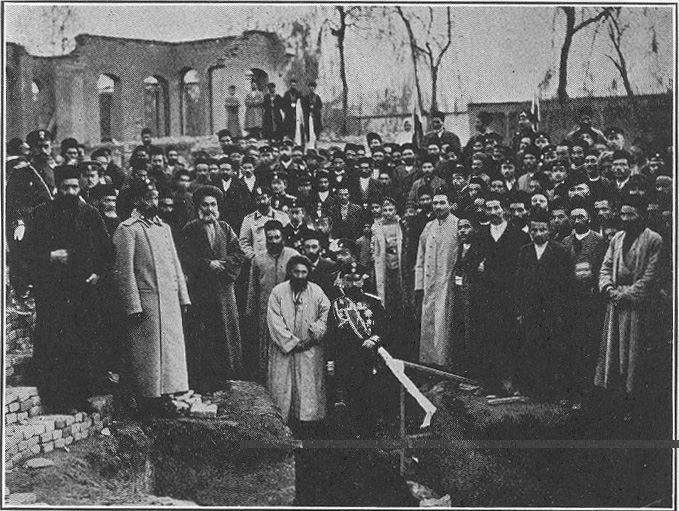
 |
 |
|
He is God, exalted is He We ask God to send one of His servants, and to detach him from Contingent Being, and to adorn his heart with the decoration of strength and composure, that he may help his Lord amidst the concourse of creatures, and, when he becometh aware of what that been revealed for His Majesty the King, that he may arise and take the Letter, by the permission of his Lord, the Mighty, the Bounteous, and go with speed to the abode of the King. and when he shall arrive at the place of his throne, let him alight in the inn, and let him hold converse with none till he goeth forth one day and standeth where he [i.e., the King] shall pass by. And when the Royal harbingers shall appear, let him raise up the Letter with the utmost humility and courtesy, and say, "It hath been sent on the part of the Prisoner." And it is incumbent upon him to be in such a mood that, should the King decree his death, he shall not be troubled within himself, and shall hasten to the place of sacrifice saying, "O Lord, praise be to Thee because that Thou hast made me a helper to Thy religion, and hast decreed unto me martyrdom in Thy way! By Thy Glory, I would not exchange this cup for [all] the cups in the worlds, for Thou hast not ordained any equivalent to this, neither do Kawthar and Salsabil rival it!" But if he [i.e. the King] letteth him [i.e. the messenger] go, and interfereth not with him, let him say, "To Thee be praise, O Lord of the worlds! Verily I am content with Thy good pleasure and what Thou hast predestined unto me in Thy way, even though I did desire that the earth might be dyed with my blood for Thy love. But what Thou willest is best for me: verily Thou knowest what is in my soul, while I know not what is in Thy soul; and Thou art the All knowing, the Informed."
"Bahá'í Year Book" Vol. 1 - 1925-1926 pp. 79-81 THE MASHRIQU'L-ADHKAR OF 'ISHQABAD BY CHARLES MASON REMEY ISHQABÁD, one of the chief cities of Russian Turkistán, is just north of the Elburz mountains, which separate the desert plain of western Turkistán on the north from Persia on the south. The city lies on a plain a short distance from the mountains, which here are quite rugged and rocky. The town is quite modern in aspect, being laid off with gardens and broad streets meeting at right angles. Rows of trees along the sidewalks remind one of a western city, while the low buildings, walled gardens, and waterways, which flank the streets and are fed with water coming from streams from the nearby mountains, are strikingly oriental in character. This city was but a huddle of mud huts when Bahá'u'lláh first directed some of His followers to settle there during the days of the most severe Bahá'í persecutions in Persia. There in 'Ishqábád these friends found a refuge of peace and tranquillity where the Russian government protected them allowing them the free exercise of their faith; thus the city became in reality as well as in name the City of Love*. The Bahá'ís of 'Ishqábád form a strong element in the life of the place, and they are highly thought of and protected by the government. The Bahá'í Cause was first brought to the public notice in 'Ishqábád some thirty-five or forty years ago by a martyrdom. It was the case of a learned man of some prominence, who met his death through receiving wounds at the hands of two assassins. These two individuals had been hired to do the deed by five Moslems, who took this measure to try to stop the spread of the Cause in that city. The Russian authorities took the matter in hand and condemned to death all of the seven men. The Bahá'ís then petitioned the governor to spare their lives. He not having authority to do this, a petition to the same effect was sent to the Czar, who granted it, and thus the prisoners were sent in chains to the mines of Siberia. Here is but another instance of the growth of the Cause through persecution, for from that time on the government not only allowed the Bahá'ís to worship as they chose, but it protected them and showed them special favors. During all of the governmental changes in Russia the Bahá'ís have continued in safety there since it is understood that they are obedient servants of the government and harbor no sedition against the law of the land. At about the close of the first decade of the Ministry of the Master 'Abdu'l- Bahá, some of the friends in the Orient arose fired with spiritual fervor to build the first great Mashriqu'l-Adhkár. Following the guidance of the center of the Covenant, 'Ishqábád was the place chosen for this service, and to direct this vast undertaking Hájí Mírzá Muhammad Taqí Afnán one of the most tried and venerable of the friends of the Cause was chosen by the Master. The Master 'Abdu'l-Bahá Himself established the style and the general lines upon which the Temple was built namely, that it should be built upon the plan of a regular nine sided polygon surrounded by loggias and in the midst of a garden at the intersection of nine avenues, with its principal entrance facing the Direction of the Holy Land the composition of the building being similar to that of some of the great temples of Persia and India. The services of an engineer and architect were secured, and the Bahá'ís throughout the Orient arose with fervor to give of their means toward the building and within a very few years the building was completed. The Mashriqu'l-Adhkár stands in the heart of the city; its high dome standing out above the trees and house tops being visible for miles to the travelers as they approach the town. It is in the center of a garden bounded by four streets. In the four corners of this enclosure are four buildings. One is the Bahá'í school; one is the traveler's house, where pilgrims and wayfarers are lodged; one is for the keepers, while the fourth one is to be used as a hospital. Nine radial avenues approach the Temple from the several parts of the grounds, one of which, the principal approach to the building, leads from the main gateway of the grounds to the principal portal of the Temple. In plan the building is composed of three sections; namely, the central rotunda, the aisle or ambulatory which surrounds it, and the loggia which surrounds the entire building. It is built on the plan of a regular polygon of nine sides. One side is occupied by the monumental main entrance, flanked by minarets-a high arched portico extending two stories in height recalling in arrangement the architecture of the world famous Taj Mahal at Agra in India, the delight of the world to travelers many of whom pronounce it to be the most beautiful temple in the world. Thus the principal doorway opens toward the direction of the Holy Land. The entire building is surrounded by two series of loggias-one upper and one lower-which open out upon the garden giving a very beautiful architectural effect in harmony with the luxuriant semi-tropical vegetation which fills the garden. The principal feature of the interior is the rotunda beneath the dome, which latter is the dominant feature of the exterior. On the main floor the principal entrance is through the large doorway, but there are also several minor doors, which connect the ambulatory with the loggia. An abundance of light is admitted through the windows in the upper portion of the rotunda, as well as through the windows of the upper gallery and ambulatory, which open upon the loggias. The interior walls of the rotunda are treated in five distinct stories. First, a series of nine arches and piers which separate the rotunda from the ambulatory. Second, a similar treatment with balustrades which separate the triforium gallery (which is above the ambulatory and is reached by two staircases in the loggias placed one on either side of the main entrance) from the well of the rotunda. Third, a series of nine blank arches filled with fretwork, between which are escutcheons bearing the Greatest Name. Fourth, a series of nine large arched windows. Fifth, a series of eighteen bull's eye windows. Above and resting on a cornice surmounting this last story rises the inner hemispherical shell of the dome. The interior is elaborately decorated in plaster relief work. The writer is under the impression that eventually it is the intention to treat the interior in colors and gold, but when he visited 'Ishqábád an 1901 it was still in the simple white stucco. The exterior is also done in stucco, which in that climate resists quite well the action of the elements. The walls, which are of brick, are massively built, while the floors and dome are of concrete and iron. The whole structure impresses one by its mass and strength. The rearing of this temple in the east has been a great source of strength to the Bahá'í people the world round for through thus expressing their unity through sacrificing to build this temple of God, the Bahá'ís of the Orient have become stronger and more united than ever before. Who can estimate the effect that is produced by this building? It is the cause of great strength and unity among the Bahá'ís of the world, being the House of Unity open to all peoples, it is a haven of rest to many a soul and a beacon to guide those who seek the Kingdom of God. *Ishqabad means City of Love. |

